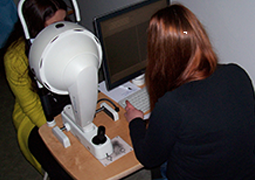Aims: To confirm current knowledge about the causes of refractive errors in adults. To evaluate the influence of systemic, i.e., primary curvature and, on the other hand, axial causes of refractive errors of the eye, in comparison with the Gullstrand model of the eye expressed by axial length and corneal curvature ratio.
Material and Methods: The basic sample included 60 eyes of 30 subjects with an average age of 22.3 ±1.1 years. There were 3 men and 27 women in the group. They were young, generally healthy individuals, without serious eye pathologies. The basic sample was divided into research (n = 36) and control group (n = 24). We measured the axial length of the eye using the IOL MASTER 500 optical biometer (Carl Zeiss Meditec, Jena, Germany). We measured the topographic and keratometric values of the cornea using the Pentacam HR device (Oculus GmbH, Wetzlar, Germany). We obtained the objective refraction values by measuring them on a standard instrument automatic refractometer TRK-1P (Topcon Corp., Tokyo, Japan). We determined the axial length of the eye (AXD), the average value of keratometry (KRT) and the spherical equivalent of the refractive error (SE) as significant variables. The evaluation of variables was carried out by comparison with the Gullstrand model of the eye.
Results: We calculated the ratios of the median axial length of the eye and the median keratometry in the research group with myopia (AXD/KRTM = 3.18 with IQR 0.1) and the control group (AXD/KRTK = 2.93 with IQR 0.1). The difference between the two groups was statistically significant (p < 0.001). The percentage expression of axial and curvature causes of ametropia was 72/28% in the myopic group and 83/17% in the control group.
Conclusion: Our study confirmed that the AXD/KRT parameter is a significant indicator of the cause of the refractive state of the eye, with the important influence of axial length on this parameter.

